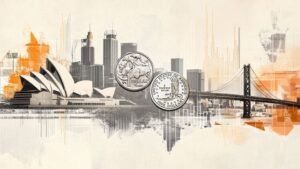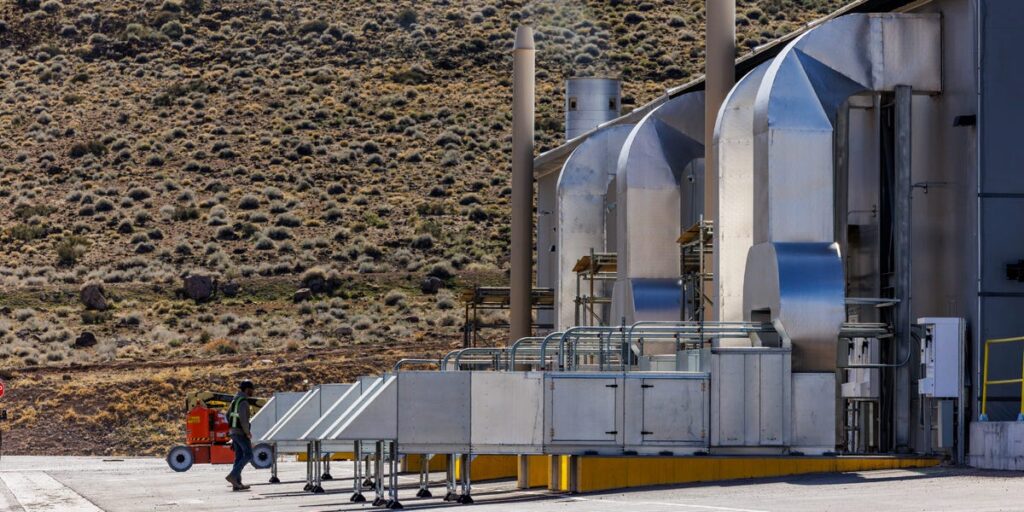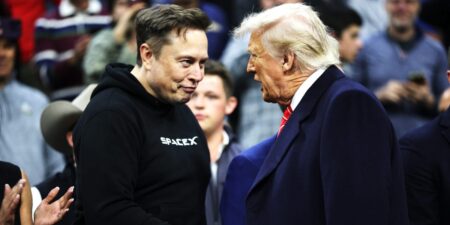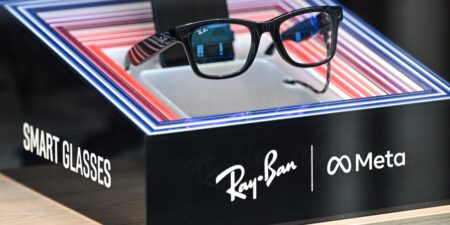In the high desert 25 miles east of Reno, Gooseberry Mine is etched into the dusty Nevada hills. Until 1990, gold was dug out of the ground here. Now it’s mostly abandoned.
In late March, I stood a few hundred yards away in a makeshift chemistry lab few people have been allowed to enter. My tour guide, Adam Kirby, a project manager at Redwood Materials, held up a small capsule containing dark powder.
“Black gold,” he said, smiling.
The substance is known as Cathode Active Material, or CAM, a combination of metals and minerals that makes up roughly 60% of the value of EV batteries and 15% of the entire price of an electric vehicle.
Oil is the original black gold, of course. This has powered automobiles for a century. Now, though, EVs are steadily replacing the internal combustion engine with what Tesla and the rest of the industry hope is a more sustainable alternative.
For this to really happen, we must recycle the big battery packs inside all these EVs. Redwood Materials, run by Tesla cofounder JB Straubel, is building North America’s biggest battery recycling operation. And CAM is the company’s next big bet.
Straubel has been hacking away at this problem for almost a decade. Since Redwood was founded in 2017, the startup has raised about $2 billion from big investors, including Fidelity, Goldman Sachs, Baillie Gifford, and Amazon.
Today, Redwood recycles more than 70% of all the lithium-ion batteries in North America. If you’ve ever handed old laptops or smartphones to a recycling center in the US or Canada, it’s likely they ended up on a giant lot in front of Redwood Materials’ 300 acre desert campus.
The company carefully heats these old batteries to just the right temperature to tease out the base ingredients, which include nickel, manganese, cobalt, and lithium. By themselves, these metals are valuable and Redwood has generated hundreds of millions of dollars in revenue by selling this raw material into the EV supply chain.
The next step for the company is combining this into CAM, which is a lot more valuable. Hence the name: new black gold. Instead of digging it up, Redwood conjures it into being through chemistry at industrial scale.
It’s an expensive and technically complex bet for Redwood, Straubel, and his investors. While driving down from the lab with Kirby, the project manager, we passed a building under construction that was so huge it made the nearby earth-moving trucks look like toys. This will house most of the full-scale CAM production process, featuring a heated conveyor belt more than 150 feet long.
“Things like Redwood are multibillion-dollar capex, ambitious projects. You must back people with experience and gravitas who can execute,” said Chris Evdaimon, an investment manager at Baillie Gifford, who also visited the site recently.
“To raise equity and debt, while having the trust of governments,” he added, “not many people can pull this off.”
“Infinitely recyclable”
When I got back down the hill, I was ushered into the main Redwood office building on campus and met Chief Commercial Officer Cal Lankton in the “Nickel” office (next to the “Manganese” and “Lithium” rooms, of course).
He recounted how Redwood got started through a surprising revelation: The ingredients of lithium-ion batteries can be reused over and over. Unlike the original black gold, these materials don’t go up in smoke or wear out.
“That was the foresight on JB’s part,” Lankton said. “That’s what differentiates this automotive transformation from previous ones — the batteries themselves are infinitely recyclable.”
Redwood’s processes can now recover about 98% of the critical minerals from batteries. The problem is that once this stuff has been salvaged, it must be shipped overseas, mainly to China, where it’s refined and combined into useful products such as CAM.
By the time this material goes into a new battery cell in a US gigafactory, it has traveled roughly 50,000 miles from being shipped to Asia and then back again, according to Baillie Gifford’s Evdaimon.
That’s massively inefficient. If the US and Europe really want to meet lofty goals such as having half of cars being electric by 2030, a homegrown industry is needed. “Redwood Materials is essential for this,” Evdaimon added.
Redwood’s circle
Redwood’s solution is what Lankton calls a “circular battery value chain,” and he says no one is doing this at scale yet in the Western world.
The start of Redwood’s circle begins with getting as many used batteries as possible. This includes production scrap from gigafactories, such as the ones Panasonic runs to supply Tesla, but also many other sources.
Redwood has massively expanded the number of ways it gets old batteries via contracts with companies such as Toyota, VW, Ford, GM, Amazon, and BMW. Redwood often pays to access this supply, betting it can make more money by turning this unwanted, hazardous scrap into the new black gold.
When you walk into Redwood Materials’ high desert office in Nevada, there’s even a black letterbox where visitors and staff can drop off old laptops and phones — or anything else that has a rechargeable battery.
The company now handles more than 20 gigawatt hours worth of lithium-ion batteries a year, the equivalent of almost 1.6 billion cellphones.
A dusty lot
The result is a dusty lot full of batteries in front of the Redwood office that stretches halfway to the horizon. Kirby drove me around to see the different types of batteries arranged in squares with gaps of a few yards to prevent runaway fires.
Some of these batteries still have a charge, so they must sit outside to shed this remaining electricity so they’re safe to process.
I wanted to snap photos, but Kirby said no up-close pics. Some partners don’t want their old gear exposed to the public like this. Although, I did see a battery from a Hummer EV that was so big it took up a sizable portion of one storage square.
A Rube Goldberg machine
Then, we drove up the hill through Redwood’s campus to near the top. There, batteries are carefully heated up to release the minerals and metals.
Some volatile organic compounds are released by this part of the process. These and other unwanted by-products are processed through a winding maze of giant tubes and collected and cleaned with what are essentially huge HEPA filters, according to Kirby. It looked like a giant Rube Goldberg machine, sparkling in the desert sun.
Kirby said some other battery recycling companies don’t spend much time or money on this painstaking step, making their facilities less environmentally friendly.
Next, a hydrometallurgy process refines and purifies the metals, minerals, and chemicals that are needed for CAM.
“Redwood’s equipment was bought from other places, but they have made many adjustments. This is truly novel,” said Baillie Gifford’s Evdaimon. “There are a hundred small things they’ve done to tweak and upgrade, and collectively, this makes Redwood the most efficient and innovative recycler for this industry in the Western world.”
1.3 million EVs a year
Once these ingredients have been isolated, they would typically be shipped to Asia. Starting in early 2026, Redwood will instead combine them into CAM inside the massive white campus building that’s being finished as I write this. (There’s enough space to build several more of these facilities on site, depending on how Redwood’s big bet goes).
Redwood estimates that North America will need 12 million tonnes of CAM by 2030, none of which is currently produced at commercial scale outside of China, Korea, and Japan. The company expects to be the first in North America.
In the coming years, Redwood aims to churn out 100 gigawatt hours worth of CAM per year. That would enable production of enough batteries to power 1.3 million EVs annually.
“What’s beautiful about this business: So many partners and plants will take anything that Redwood makes right now. These ingredients are already in demand,” said Evdaimon. “And the more processes you add up the value chain, the more valuable your product gets and the better the profit margins are. There are a lot of processes that Redwood is adding.”
Making this stuff well is hard
Reclaiming nickel, cobalt and other battery ingredients, rather than digging up virgin material from dirty, dangerous mines, is a heck of a lot more efficient. According to Redwood Materials, it uses 80% less energy, generates 70% fewer CO2 emissions, and requires 80% less water.
Actually making good CAM, though — up to the high specifications of battery manufacturers — is really hard.
You must get just the right combination of nickel, manganese, cobalt, and lithium, along with tiny amounts of rare-earth minerals and other ingredients. That forms a lattice structure that has to be strong but also allows the free movement of lithium ions back and forth between the battery’s cathode and anode as it charges and discharges electricity.
“At the end, it literally looks like a black powder that we put in big plastic bags and ship to the customer,” Lankton said. “But the work that goes into making this is incredibly technical.”
Three stages
There are three stages of Redwood’s CAM journey. The first is the lab that I was allowed into. This is where the core chemical processes are devised and tested on a small scale.
Nearby is a demonstration plant that is a scaled-down version of Redwood’s ultimate facility. Here, the company operates the same equipment and processes, such as rotating kilns, to prove its CAM production methods work consistently.
The final stage is doing all this on a massive scale in the giant CAM building down the hill from the lab and demo plant.
“We’re in that middle phase, but we’ve derisked a lot of that final step,” Lankton told me. “That’s why we have a high degree of confidence in our ability to achieve our targets.”
So confident, in fact, that Redwood already has multibillion-dollar contractual offtake agreements with Toyota and Panasonic for its CAM.
Copper foil and Northvolt
This endeavor is not just technically complex, though. There are other risks when you’re competing with China’s manufacturing might.
Redwood used to make copper foil, too, which is the main ingredient for the anode in batteries. However, Chinese companies began churning this out in massive quantities, and prices plummeted.
Lankton said blood, sweat, and quite a bit of capital went into the copper foil business, and he credited Straubel with the ability to make the painful decision to pause this part of the business.
“That is, perhaps, a point of pride to differentiate us from our peers,” Lankton added. “We’re not dogmatic; we’re not going to take a business plan and just do it until we think it works and run ourselves into the ground.”
In March, Northvolt, a European battery recycling startup, went bankrupt after chewing through $15 billion in funding.
Lankton said he admired Northvolt’s ambitious plans but said the company may have gone too far by trying to make full batteries itself rather than being just a supplier of materials like Redwood.
Tariff timing
While Northvolt’s demise paints a dour picture for battery recycling, other factors may be playing into Redwood’s hands.
The Inflation Reduction Act from 2022 has big incentives for US battery production. And this year, Donald Trump’s tariff barrage favors domestic manufacturing.
Being the first major CAM producer in the US is looking like a well-timed initiative right now. But Lankton said Redwood isn’t resting on its laurels.
“Why should someone want to buy Redwood’s CAM?” he asked me, rhetorically, in the company’s Nickel office.
Firstly, Redwood has to be competitive on price globally, irrespective of incentives, tariffs, or other artificial factors.
Second, the company must have the technical prowess to pull this off. “There’s hardcore particle engineering that goes into this CAM,” Lankton explained. “It has to be consistent with anything else one of our customers can buy. So we have to technically meet or exceed those specifications.”
Then, finally, he conceded that there is value in having a reliable, sustainable, secure US source of battery material as questions swirl about the future of global trade.
“But if number one and number two aren’t true, no one’s gonna buy Redwood’s CAM,” he warned.
Read the full article here
















